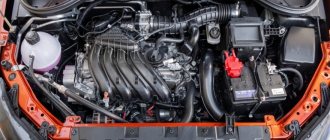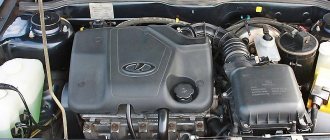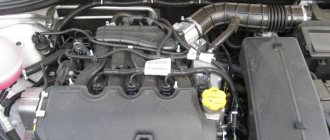Engine 11183 is the engine installed on the cheapest versions of budget VAZ cars: the Lada Kalina sedan (2001 - 2011) and the Lada Granta model that replaced it (2011). They replaced the Samara family of cars that had been produced for a long time.
The VAZ 11183 engine is a product of modernization of the well-known 2111 engine, which in turn replaced the outdated (carburetor) 21083.
Engine 11183 (another name for VAZ 21114 engine) differs from 2111 (cylinder capacity 1.5 liters):
- height of the cylinder block;
- increased piston stroke.
Due to this, the designers managed to increase the volume of the cylinders and increase the engine power. As a result of the work carried out, engine 11183 significantly improved its performance characteristics (reliability, environmental friendliness, etc.). Due to the fact that its assembly is carried out at various production sites of AvtoVAZ OJSC, the engine is known to car enthusiasts under the names:
- 11183;
- engine 21114;
- 2114;
- Kalina motor;
- motor Kalina, etc.
Technical data VAZ 11183 1.6
- VAZ 11183 1.6 is a four-stroke gasoline engine, the four cylinders of which are arranged in one row.
- Power supply of the power unit, injection, distributed fuel injection.
- The cylinder block of the Lada Kalina internal combustion engine is made of especially durable cast iron. The gas distribution mechanism is single shaft, has 8 valves. The timing mechanism is driven by a toothed belt from the crankshaft pulley.
- The engine piston has a stroke less than the cylinder diameter of 75.6 mm and 82 mm, respectively. The compression ratio of the internal combustion engine is 9.6. The fuel used is AI 95. It is permissible to use AI 92, for which you need to change the ignition timing.
- Power VAZ 11183 1.6, at 5200 rpm min., 81 l., sec. Torque at 3000 rpm, min., 125 Nm.
- Environmental compliance standards: Euro 2, Euro 3.
Fuel consumption
Fuel consumption when driving around the city is 8.8 liters per 100 km, mileage. When driving on the highway 6.2 liters. Total consumption is 7.6 liters per 100 km, mileage.
Oil consumption
The permissible consumption of motor lubricant is 50 grams per 1 thousand km. Types of oil used: 5W40, 10W40, 5W30, 15W40. The volume of engine lubricant in the VAZ 11183 1.6 engine is 3.5 liters. When changing, fill in 3.2 liters. Manufacturers recommend changing the oil every 15 thousand km.
Resource
Engine operating life according to factory data is 150 thousand km. In reality, in the right hands, the VAZ 11183 1.6 can last up to 300,000 kilometers.
Conclusion
The Lada Kalina engine has several options. Thus, numerous variants of power units were installed on vehicles, which were developed for other models produced by AvtoVAZ. The engine has a simple design and is quite easy to maintain and repair.
The choice of oil for the Kalina engine is a very sensitive issue, since it determines how long and efficiently the main unit of the car will work. Therefore, it is recommended to fill in the fluid recommended by the manufacturer.
General design features of internal combustion engines
The VAZ 11183 1.6 engine is a modified version of the already well-known carburetor power unit VAZ 21083. Most of the design elements are borrowed from this model. The cast iron cylinder block also has four in-line cylinders. But the aluminum cylinder head is adapted for distributed fuel injection. It has an overhead camshaft. The valves are driven by fists through pushers. Hydraulic compensators are not provided on this engine model. Because of this, periodic adjustment of the valves is required. Which you can do yourself by selecting the required number of steel washers.
The 11183 1.6 engine block is very similar to the VAZ 21083 power unit block. The only thing that has changed is the height of the cylinder block. As a result of these changes, the stroke of the piston group increased. It became 75.6 mm, instead of the previous 71 mm. Accordingly, engine capacity increased from 1.5 liters to 1.6 liters.
Design features of the VAZ 11183 timing belt
The camshaft of the gas distribution mechanism is driven from the crankshaft pulley using a toothed belt. Belt tension, unfortunately for drivers, is manual and brings a lot of trouble. Therefore, the belt often has to be tightened manually. A very important and pleasant point for owners of such an internal combustion engine is that when the timing belt breaks, the pistons do not meet the valves. This is possible thanks to the special design of the pistons, which has a recess in the upper part.
Maintenance
According to AvtoVAZ recommendations, the 11183 engine must be serviced according to the regulations:
| Maintenance object | Time (month) or mileage (10,000 km), whichever comes first |
| Timing drive | 36/ 1 |
| Battery | 12/2 |
| Valve clearance | 24/2 |
| Crankcase ventilation | 24/2 |
| Belts that drive attachments | 24/2 |
| Fuel line and tank cap | 24/2 |
| Engine oil | 12/1 |
| Oil filter | 12/1 |
| Air filter | 12 – 24/4 |
| Fuel filter | 48/4 |
| Heating/cooling circuits | 24/4 |
| coolant | 24/4 |
| Oxygen sensor | 10 |
| Spark plug | 12 – 24/2 |
| Exhaust manifold | 12/1 |
By default, the cooling system has a volume of 7.8 liters. Red Felix Carbox 40 antifreeze is usually poured on the conveyor. Replacement is made with any coolant, taking into account the temperature range of 85 degrees. Since the internal combustion engine device is quite simple, the maintenance operation can be performed on your own.
Modifications of the internal combustion engine VAZ 11183 1.6
This engine underwent a major modernization in 2011. On the new model, the receiver has been enlarged, and the throttle valve has received an electronic control system. The type of throttle control is called E-gas. The new engine acquired its own VAZ 11183-50 index, and its power increased to 82 hp. What is also important is that the VAZ 11183-50 began to comply with European compliance standards Euro 4.
It should be noted that in parallel with the VAZ 11183 engine, the VAZ 21114 engine was produced. By and large, this is the same engine. Most systems, components and mechanisms are identical.
However there are some differences:
- in the power system of the VAZ 21114 engine they used a completely different generator 5132.3771 for 90 Amp hours;
- a new fastening method was used to mount the generator;
- To drive the generator, a new belt with a thickness of 882 millimeters was used. The mechanism for tensioning the belt has also been changed.
All other components, systems and mechanisms of the engine are completely the same, despite the fact that the motors were produced in different production shops.
What cars was it used in?
The manufacturer AvtoVAZ used engine 11183 to equip several car models:
- Lada Kalina – station wagon, sedan, hatchback;
- Lada Kalina II – second generation in similar bodies;
- Lada Granta – sedan, hatchback;
- 21101 – four-door sedan;
- 21112 – five-door station wagon;
- 21121 – short five-door hatchback;
- 2113 (since 2011) – three-door hatchback;
- 2114 (2006 – 2013) – five-door hatchback;
- 2115 Lada Samara-2 (2007 – 2012) – compact sedan.
Lada Granta liftback
Improved engine characteristics ensured the demand for cars of a similar configuration.
Recommendations for servicing the Lada Kalina engine
The service life of any engine depends on proper maintenance from the very first days of operation; the VAZ 11183 1.6 engine is no exception to the rule.
The manufacturer recommends servicing this engine in the following order:
- During the first kilometers of driving, the entire car undergoes grinding in of parts, including the engine. The grinding-in period is called the running-in period. It lasts about 1.5 thousand kilometers. After it expires, you need to replace the engine lubricant and the oil filter element.
- The next stage of maintenance must be performed after a mileage of 10 thousand kilometers. The engine oil and oil filter must be replaced. Also, at this stage it is necessary to change the air filter, measure the compression in the cylinders and adjust the valves.
- After 20,000 kilometers, it is necessary to diagnose all mechanisms and systems of the internal combustion engine. Naturally, you need to change the engine oil, since it must be replaced every next 10,000 kilometers.
- After 30 thousand, you only need to change the engine lubricant and filter element
- After a mileage of 40 thousand km, many engine elements and parts must be replaced:
- replacing the air flow filter element;
- replacing the fuel filter element;
- replacing the timing belt and roller;
- replacing the alternator belt if necessary;
- replacing the pump at the slightest play in the fuel pump pulley;
- replacing the valve cover gasket;
- other parts requiring replacement;
- In addition to replacing parts, during this period of operation the valves should be adjusted and diagnostics of the internal combustion engine systems should be carried out.
Subsequent maintenance must be carried out in accordance with points 2 and 5. The exception is motor oil and filter. They need to be replaced every 10 thousand kilometers.
Oil change video
Advantages and disadvantages
The advantage of the 11183 engine is the cylinder head of the original design. However, it was subsequently further modified into the ICE 11186, adding volume to the combustion chambers. The downside is the generator belt tensioner - the drive is constantly over-tightened, a deflection of 10 mm is not ensured without slipping, so the belt life is reduced and it has to be changed more often. This defect was corrected only in the next version of the motor 11186.
The integrated catalytic collector assembly in the engine was initially unfinished:
- the tubes of the four channels are short;
- flows converge inside the block at almost one point;
- exhausts collide and create opposition to each other;
- the shape of the block did not allow changing the arrangement of the tubes.
Catcollector 11183
When installing the engine on the Lada Granta, the cabin heat exchanger was connected to the thermostat in series. All the coolant passed through it along a small circuit, the response temperature error was 5 degrees instead of the required 2 degrees.
Possible malfunctions of VAZ 11183 1.6
The VAZ 11183 engine is an improved version of the VAZ 21083. Most of the possible malfunctions for these engines are similar:
Flow sensor
For cars, a number of VAZ models, including Lada Kalina and Lada Granta, stopping the engine while driving is popular. Experienced drivers know that the culprit of the breakdown is the sensor responsible for mass fuel consumption. When replacing this sensor, the engine will start without problems.
Oil leaking
A popular problem is engine lubricant leaks. Oil can leak through the valve cover gasket, gaskets and seals. Sometimes a leak can be so critical that complex repairs cannot be avoided. Critical failures include oil leakage through the crankshaft seals.
Overheat
Overheating of the VAZ 11183 power unit occurs due to the thermostat. Unfortunately, the quality of domestic spare parts leaves much to be desired. A newly installed thermostat may not work. The motor may overheat, or on the contrary, it may not heat up.
Engine knock
Knocks in the power unit are a real problem for many VAZ cars. It is necessary to take into account the fact that the engine knocks when cold. If the engine has already warmed up and the valve clearances have been adjusted, the problem may be more serious. To determine the problem, you will need to diagnose the internal combustion engine.
ECU
The control electronics on the VAZ 11183 1.6 engine is one of the sore spots. Most drivers have encountered its replacement. There may be several reasons for this. For example: increased fuel consumption, the engine cannot develop full power, idle speed failure.
Engine tripping
If the engine starts to stall, you need to check the spark plugs. If the spark plugs are OK, then the ignition coil has failed. Very rarely a valve can burn out.
The revolutions are floating
If the engine speed fluctuates, then with a high probability it can be said that a dirty throttle valve is to blame. Often the cause may be a failed electronic sensor.
Crankshaft bearings
If, when accelerating, you can hear the sound of metal in the engine, then there is a high probability that the crankshaft liners are rattling. Further operation of the vehicle is not advisable until the problem is resolved. Otherwise, scuffs may form on the crankshaft journals.
As can be seen from everything described above, the VAZ 11183 power unit has many weak points and possible malfunctions. However, given the simplicity of the engine design, drivers fix most internal combustion engine problems themselves. Here, it must be said that spare parts for the VAZ 11183 are low in cost. Thanks to these circumstances, many domestic drivers fell in love with this engine. They consider it a reliable, easily repaired power unit.
Powertrain tuning
Tuning the Lada Kalina engine is carried out by analogy with other power units produced by AvtoVAZ. So, the first thing motorists do is chip tuning. Software settings that allow you to either increase power or reduce consumption. There is also an option to make a balance between two important indicators.
The second option is to overhaul the engine itself and bore it. The power unit is equipped with a lightweight piston group, as well as other tuning parts. Typically, as practice shows, motorists change elements of the cooling and air supply systems.
It is recommended to carry out tuning of the Lada Kalina engine in special studios and services, where professionals can do everything and configure it correctly.











